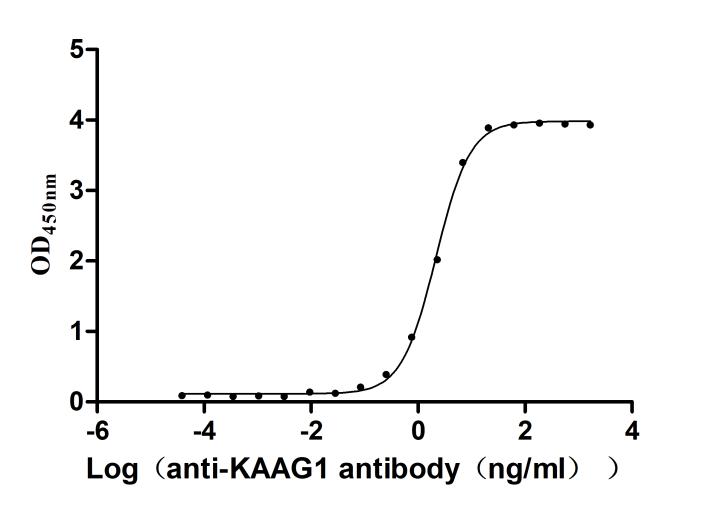Recombinant Mouse G-protein coupled receptor 4 (Gpr4)
-
货号:CSB-CF807408MO
-
规格:
-
来源:in vitro E.coli expression system
-
其他:
产品详情
-
基因名:
-
Uniprot No.:
-
别名:Gpr4; G-protein coupled receptor 4
-
种属:Mus musculus (Mouse)
-
蛋白长度:full length protein
-
表达区域:1-365
-
氨基酸序列MDNSTGTGEGCHVDSRVDHLFPPSLYIFVIGVGLPTNCLALWAAYRQVRQHNELGVYLMN LSIADLLYICTLPLWVDYFLHHDNWIHGPGSCKLFGFIFYSNIYISIAFLCCISVDRYLA VAHPLRFARLRRVKTAVAVSSVVWATELGANSAPLFHDELFRDRYNHTFCFEKFPMERWV AWMNLYRVFVGFLFPWALMLLCYRGILRAVQSSVSTERQEKVKIKRLALSLIAIVLVCFA PYHALLLSRSAVYLGRPWDCGFEERVFSAYHSSLAFTSLNCVADPILYCLVNEGARSDVA KALHNLLRFLASNKPQEMANASLTLETPLTSKRSTTGKSSGAVWAVPPTAQGDQVPLKVL LPPAQ
Note: The complete sequence including tag sequence, target protein sequence and linker sequence could be provided upon request. -
蛋白标签:N-terminal 10xHis-tagged
-
产品提供形式:Liquid or Lyophilized powder
Note: We will preferentially ship the format that we have in stock, however, if you have any special requirement for the format, please remark your requirement when placing the order, we will prepare according to your demand. -
缓冲液:Lyophilized from Tris/PBS-based buffer, 6% Trehalose, pH 8.0
-
储存条件:Store at -20°C/-80°C upon receipt, aliquoting is necessary for mutiple use. Avoid repeated freeze-thaw cycles.
-
保质期:The shelf life is related to many factors, storage state, buffer ingredients, storage temperature and the stability of the protein itself.
Generally, the shelf life of liquid form is 6 months at -20°C/-80°C. The shelf life of lyophilized form is 12 months at -20°C/-80°C. -
货期:Basically, we can dispatch the products out in 1-3 working days after receiving your orders. Delivery time may differ from different purchasing way or location, please kindly consult your local distributors for specific delivery time.Note: All of our proteins are default shipped with normal blue ice packs, if you request to ship with dry ice, please communicate with us in advance and extra fees will be charged.
-
注意事项:Repeated freezing and thawing is not recommended. Store working aliquots at 4°C for up to one week.
-
Datasheet & COA:Please contact us to get it.
相关产品
靶点详情
-
功能:Proton-sensing G-protein coupled receptor couples to multiple intracellular signaling pathways, including GNAS/cAMP, GNAQ/phospholipase C (PLC), and GNA12/GNA13/Rho pathways. Acidosis-induced GPR4 activation increases paracellular gap formation and permeability of vascular endothelial cells through the GNA12/GNA13/Rho GTPase signaling pathway. In the brain may mediate central respiratory sensitivity to CO(2)/H(+).
-
基因功能参考文献:
- GPR4 deficiency reduces acute intestinal inflammation in a mouse colitis model. GPR4 gene expression is upregulated in inflamed mouse and human intestinal tissues. PMID: 27940273
- GPR4 blockade attenuated renal injury after IR and reduced the cell apoptosis through the suppression of CHOP expression. PMID: 29089376
- Collectively, these results posit the acid sensor GPR4 as a novel component of central blood pressure control through interactions with the renin-angiotensin system. PMID: 27681561
- knockdown of a proton-sensing G protein-coupled receptor GPR4 markedly reduced CHOP expression and endothelial cell apoptosis after hypoxia exposure. PMID: 25343248
- required for maintenance of normal acid-base homeostasis PMID: 25972512
- The results indicate that through the G12/13/Rho signaling pathway GPR4 modulates focal adhesion dynamics and reduces cell spreading and membrane ruffling. PMID: 25845498
- The data identify GPR4 and TASK-2 as distinct, parallel, and essential central mediators of respiratory chemosensitivity. PMID: 26068853
- These results suggested that, at least in part, RANKL expression by osteoblasts in an acidic environment was mediated by cAMP/PKA signaling resulting from GPR4 activation. PMID: 25668130
- GPR4 modulates glucose homeostasis by increasing insulin sensitivity. PMID: 24296356
- Reduced pathological angiogenesis and tumor growth in mice lacking GPR4, a proton sensing receptor. PMID: 22045552
- findings suggest that GPR4 activation by an acidic pH inhibits tumor cell migration and invasion, and the Rho GTPase is at least partly responsible for this phenotype PMID: 21917373
- pH sensor with an important role in regulating acid secretion in the kidney collecting duct PMID: 20798260
- These results suggest that GPR4 deficiency leads to partially penetrant vascular abnormalities during development and that this receptor functions in blood vessel pH sensing. PMID: 17145776
显示更多
收起更多
-
亚细胞定位:Cell membrane; Multi-pass membrane protein.
-
蛋白家族:G-protein coupled receptor 1 family
-
组织特异性:Detected in neurons of the brain-stem retrotrapezoid nucleus (RTN).
-
数据库链接:
KEGG: mmu:319197
STRING: 10090.ENSMUSP00000061243
UniGene: Mm.135984
Most popular with customers
-
Recombinant Macaca fascicularis Membrane spanning 4-domains A1 (MS4A1)-VLPs (Active)
Express system: Mammalian cell
Species: Macaca fascicularis (Crab-eating macaque) (Cynomolgus monkey)
-
Recombinant Mouse CUB domain-containing protein 1 (Cdcp1), partial (Active)
Express system: Mammalian cell
Species: Mus musculus (Mouse)
-
Recombinant Human Myosin regulatory light chain 12B(MYL12B) (Active)
Express system: E.coli
Species: Homo sapiens (Human)
-
Recombinant Human Kidney-associated antigen 1(KAAG1) (Active)
Express system: E.coli
Species: Homo sapiens (Human)
-
Express system: Mammalian cell
Species: Homo sapiens (Human)

















